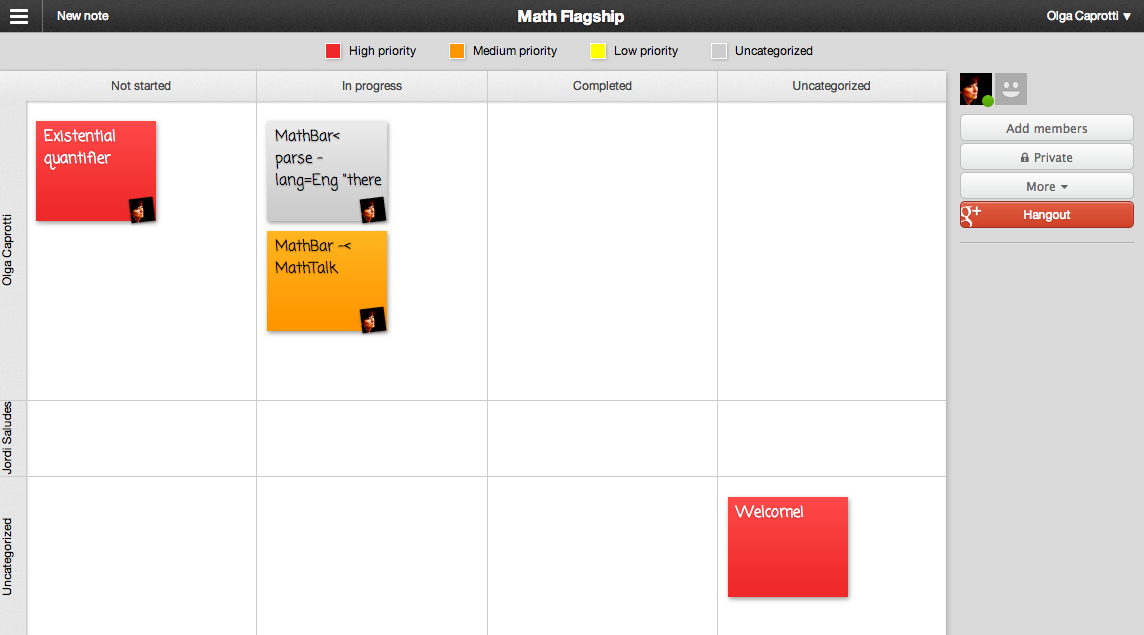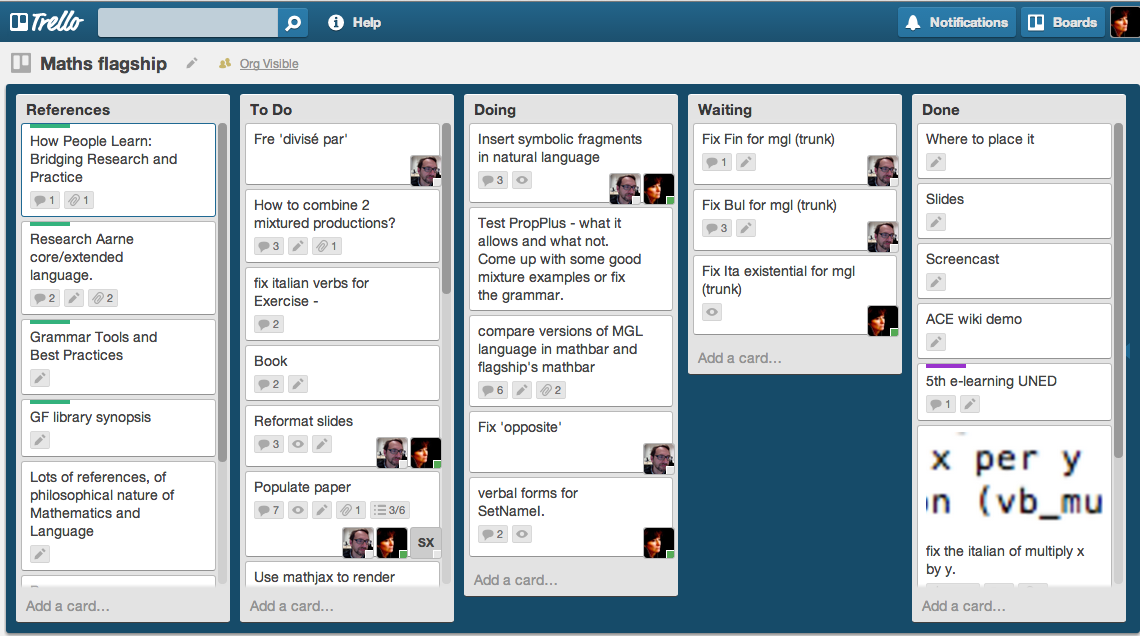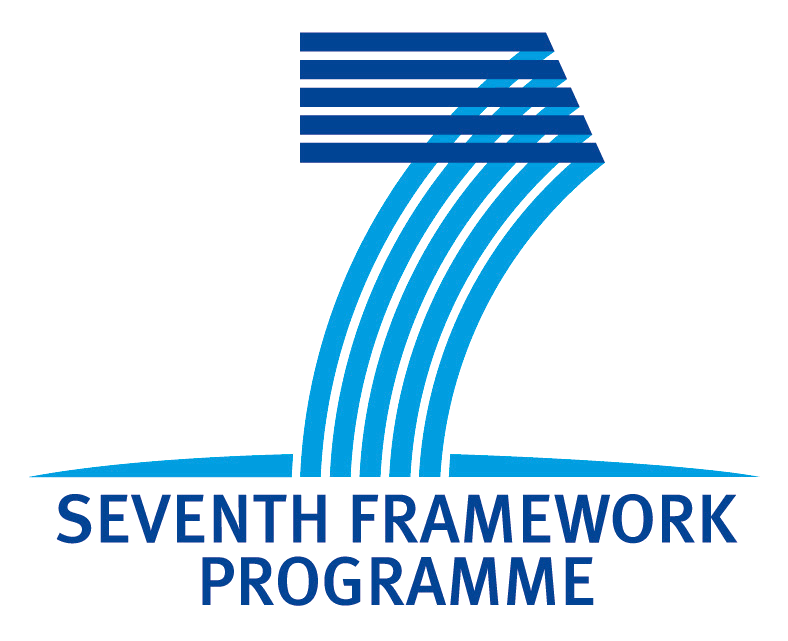3.1 Followup to the reviewers' report
Recommendation 1.
Technical coordination should be strengthened. Continuous and strict monitoring should be applied. Reviewers made several recommendations in the 1st review but most of them have not been implemented or it was unclear what was done with respect to them. As it is shown in the remarks per WP, the adoption of most of these recommendations would support monitoring of the work progress towards the project’s objectives.
The greatest effort undertaken to strengthen the coordination of the partners was to define a number of "flagships" aimed at demonstrating the integration of the MOLTO technologies. These showcase demonstrators have been developed during the final months of the project by tight cooperation of the partners, each flagship adopting and reviewing some tool or technology from a different partner.
Recommendation 2.
The recommendation from the 1st review “How grammar rules are extracted (from lexical databases, ontologies, text examples) needs to be specified in detail and a concrete schedule should be included in the updated workplan (D1.1)” has not been included in D1.1.It should be included in D2.3 “Grammar tool manual and best practices”, due in M27. This is a crucial deliverable since the best practices with respect to the other work packages should be included here
Recommendation 3.
The recommendation from the 1st review “Details on the integration steps (the integration of the vocabulary editor with the translation editor, the integration of the vocabulary editor with TermFactory (TF), and the integration of TF with the Knowledge Representation Infrastructure (KRI) of WP4) need to be provided in the updated workplan (D1.1). Concerning the integration of TF and KRI, it seems that there are overlaps between these tools. The partners must clarify which functions of these tools will be used in the case studies in order to exploit complementarities of the tools and avoid overlaps.” has not been addressed properly and is presented as still “less understood” by the WP leader. This is a major issue of concern. The problems of the integration of WP3 tools remain. These should be discussed in an updated D1.1.
Follow-up: D4.3A makes comparison between KRI and TF and suggests steps to be taken to integrate TF and KRI. The integration requires a mirror of a KRI site, whose semantic repository is open to edit with TermFactory. The resulting knowledge base in the mirror site will be grammatically enriched, so that the new information is presented to the user. Moreover, the integration can facilitate lexicon extraction for the GF grammars and the query language of KRI.
Recommendation 4.
The translator's tool s that should be developed in WP3 should not be given up. Although the WP's leader's impression is that the MT quality is too low for the tools to ever be used, the developed tools can be useful for those subdomains/language pairs where MT quality is better.
Follow-up: The development of the translator's tool has been continued, but with another platform. Deliverables 3.1 and 3.2 use GlobalSight, a translation management system, and an external editor that supports GF. However, we found that GlobalSight was not maintained, and changed to Pootle, a modern and lightweight translation platform with an active user base. D3.3 describes the integration of the GF translation to Pootle. A demo video is found at MOLTO's youtube channel.
Recommendation 5.
The recommendation from the 1st review “Critical issues with respect to the semi-automatic creation of abstract grammars from ontologies, as well as deriving ontologies from grammars, are still to be clarified. Concrete steps to handle these issues need to be specified in detail and a schedule should be included in the updated work plan (D1.1). In addition, as noted with respect to WP3, complementarities between KRI and TF should be exploited avoiding possible overlaps. Terminology should be added and abbreviations explained in Deliverable D4.1 in order to facilitate reading by non-experts in the field” should still be addressed. The issue of the two-way interoperability between ontologies and GF grammars still remains unclear, although as noted in the DoW this represents one of the two most research-intensive parts of MOLTO. This should be solved in the new versions of D4.2 and D4.3 The current version of deliverables D4.2 “Data Models, Alignment Methodology, Tools and Documentation”, and D4.3 “Grammar-Ontology Interoperability” are not approved. D4.2 is too general. For instance, a lot is said about LOD and the museum case and not on the alignment methodology. D4.3, on the other hand, does not give a clear picture of the interoperability issues and the degree of automation that can be expected. What is required for porting this to a new application? Concrete steps should be provided making clear what can be automated and what cannot with the provided infrastructure.
Follow-up:
- D4.1 includes a "Glossary" with definitions and explanations of all technical terms. (see the .pdf version of the document, available on the website)
- D4.3A gives details on the further work in the field of grammar-ontology interoperability and summarizes the achieved in WP4, WP7 and WP8 in the field(since the prototypes of these work packages are child projects of the KRI prototype). The highlights are using GF to generate SPARQL, observing it as yet another language, and also the details of (semi-)automatic verbalization of RDF facts with the help of GF.
- D4.2 was updated
- D4.3 was updated and D4.3A (annex deliverable) was published. D4.3A gives more specific details than D4.3 and explains what was achieved in the WP4 goals after M24 of MOLTO.
- In the end of D4.3A we list the steps of customization of the KRI prototype for other specific domains. A highlight is that the need of GF expert and knowledge engineer cannot be overcome; the two experts should work in collaboration to design the prototype's query language(auto-suggestions are possible) and a few iterations of mutual work might be needed to refine the result.
Recommendation 6.
The current description of work in WP6 lacks details on the prototype multilingual dialogue system to be developed. As recommended in the 1st review, an example dialogue and specifications of this prototype should be provided. These can be included in D9.1E.
Example dialog and description are available at D6.3 cover document (http://www.molto-project.eu/sites/default/files/D6.3.pdf) (Sections 1, 3 and 4).
Recommendation 7.
WP7 work should focus on the major issues examined in MOLTO, especially in relation to the grammar – ontology interoperability automation. Specific scenarios are needed for the exploitation of MOLTO tools in this case study. It is recommended to include such scenarios in deliverable D9.1E.
Follow-up:
In response, two use case scenarios were described: UC-71 and UC-72.
UC-71 focuses on grammar-ontology interoperability. User queries, written in CNL, are used to query the patent retrieval system. We defined a query language and a new query grammar in order to a) decrease the number of ambiguities in the queries and b) increase the coverage of the ontology. As a result, we come up with a more reusable grammar (YAQL), easier to maintain, that facilitates the lavour of building query grammars for the application domain and languages. NL queries are translated into SPARQL using this approach. Additional details are given in D7.3 and D4.3A.
UC-72 focuses on high-quality machine translation of patent documents, and the ultimate goal is to endow the retrieval system with the information required to enable multilinguality. We used an SMT baseline system to translate a big dataset of patents and feed the retrieval databases. The automatic translation included the semantic annotation, available only in English documents. This mechanisms allowed to extract multilingual lexicons for the domain ontology, which were used also to build the query grammars. More details are also given in D7.3.
Finally, the exploitation plans for the technologies developed within this WP, which are further discussed in D10.4, are focused on multilingual text processing and cross-lingual translation of various domain data within search and retrieval techniques.
Recommendation 8.
The recommendation from the 1st review “Preparation of a new version of D9.1 is recommended including prototype specifications and scenarios for the three case studies (WP6, WP7, WP8)” should still be addressed. A concrete evaluation methodology is needed focusing on MOLTO's major goals: How will the consortium prove that its objectives were fully/partially met? We expect to see this in D9.1E “Addendum to the MOLTO test criteria, methods and schedule” hoping that the recommendations suggested above as well as in the 1st review, in relation to D9.1, will be included there.
Follow-up: D9.1A “Appendix to MOLTO test criteria, methods and schedule” addresses these issues.
Recommendation 9.
The way the project’s web site is structured, although it contains the necessary content, affects its readability in some cases. It should contain a structure according to the work packages, including all documentation related to a specific work package.
The content published on the web site can be navigated according to the way the producer has tagged it. If the author has decided to tag a certain item as belonging to a work-package then this content will display when selecting the proper tag: e..g http://www.molto-project.eu/category/dow/potential-impact/dissemination or, for publications, http://www.molto-project.eu/biblio/keyword/88 will select the WP7-related bibliography. However, to the casual reader of the website, the distinction in work-packages is not very informative and the results are best viewed independently of the contingent organization in the work-plan. Following this principle, we have created a navigation menu that distinguishes the internal, work-plan related items from the public more general publications.
Recommendation 10.
The deliverables on the work plan (D1.1) and the dissemination plan (D10.1) should be updated at the beginning of the 3rd year.
We have adopted the methodology to continuously use online publication tools on the internal section of our web pages in order to maintain the work plan, the dissemination plan and their updates. Partners that are undergoing new activities use the news feed to inform the Consortium. Work package leaders have been given the option to create tasks, allocate and manage them. Some of the work planning has been coordinated by the partners using third party specific tools such as Trello (trello.com) and Symphonical (https://www.symphonical.com).


- Printer-friendly version
- Login to post comments
- Slides
What links here
No backlinks found.


